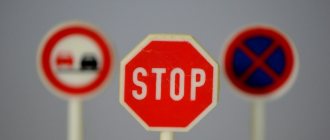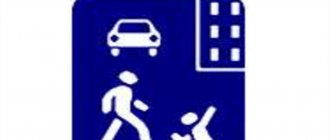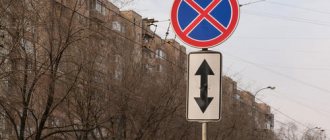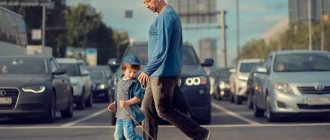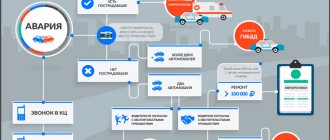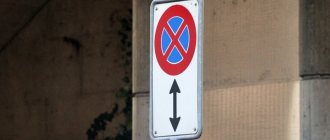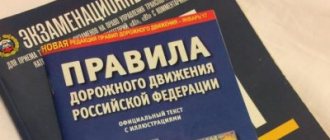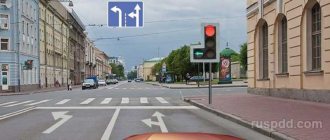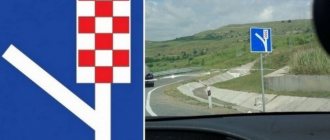When the main road changes direction, many drivers, especially beginners, have problems quickly understanding who should yield to whom. The rule for passing at such intersections sounds simple.
13.10. In the event that the main road changes direction at an intersection, drivers moving along the main road must follow the rules for driving through intersections of equivalent roads. Drivers driving on secondary roads should follow the same rules.
13.11. At an intersection of equivalent roads, the driver of a trackless vehicle must give way to vehicles approaching from the right. Tram drivers should follow the same rule among themselves. At such intersections, the tram has priority over trackless vehicles, regardless of the direction of its movement.
That is, if we decipher this rule, drivers on the main road let the obstacle on the right from the main road pass, and drivers on the secondary road let those on the main road and those driving on the right on the secondary road pass.
At the same time, all drivers should not forget about trams and pedestrians. On the main road, trams, which are also on the main road, regardless of the direction of their maneuver, and all pedestrians pass, and on the secondary road, ALL trams pass
Difficulty driving through intersections where the main road changes direction
How to remember who to skip
If you are moving along the main road, you must assess as you go who you should let through and who you shouldn’t. To make a decision quickly, remember simple mnemonic rules. These mnemonic rules will be especially useful for beginners who are drowning in the sea of information that befalls them on the road.
Attention! These rules allow you to remember the order of passage for trackless vehicles! As soon as you see tram lines, you must remember that a tram located on the same road as you always has an advantage over you. So let the trams pass, and then you can apply the passing rules for trackless vehicles.
1) When you approach an intersection and
you are on a main road and the main road turns left
mnemonic rule:
- Main left - ride like a queen
(Especially easy for women to remember; men can imagine themselves as a chess queen. Which, as you know, goes anywhere)
This means that you make any maneuvers and should not give way to any non-rail vehicle. You ALWAYS give way to pedestrians at uncontrolled intersections.
Even those drivers who are also on the main road will give way to you during any maneuver, because for them, with such a main turn, you turn out to be an obstacle on the right.
2) You drive up the main road and the main road turns right
- main to the right and interference to the right
This means that you give way during any maneuver only to those moving on the right
If you are approaching an intersection on a secondary road
Then you can remember the picture on the sign, just as you remember the waxing and waning moon
3) If you can complete the drawing so that you get the letter P, then it’s a mnemonic rule
- Home Growing - I'm unlucky
This means that you let everyone through and go through the intersection last.
4) If the main one looks like the letter C
- that mnemonic rule:
- Home Old lady - I have a bun
This means you let everyone through except those on the sidelines. For them, you are a hindrance on the right, and have an advantage.
In fact, it is especially important to remember the first two mnemonic rules, since those who are on the main road are driving at speed and must assess the situation faster than those who are driving on the secondary road and know that they need to let almost everyone pass.
But knowing all four mnemonic rules for driving through an intersection where the main road changes direction will help you crack all such tasks like nuts in the traffic police exam.
In general, as they say, it could be simpler. But no, a holy war broke out on one of the forums over the question of who gives way to whom when changing the direction of the main road. The situation is painfully simple and occurs quite often. The main road changes direction to the right. The blue car wants to drive straight and leaves the main road. Purple continues on the main road to the right. Who is inferior to whom?
see also
Comments 243
Here the broken marking line in the disputed area is interrupted for good reason - the purple one is inferior in terms of “interference on the right”.
Sorry, I didn't even look. My answer. If the markings or signs allow you to turn in more than one lane, then the blue one (if he intends to move straight) has nothing to do there, accordingly, creating an obstacle, he changes lanes, crossing the turning lanes and he went into the stump, let him wait until they let him go straight with a left turn signal. If Since neither the signs nor the markings allow turning from the second lane, then you can only turn from the right lane, respectively, the purple stupid donkey, and when changing lanes, you must let it pass, and only then turn from the right lane. But in any case, if you don’t bully, and are mutually respectful and, moreover, in solidarity, then such incidents can be overcome with a bang.
Traffic services are to blame!
Before such intersections, it is necessary to place signs “Direction of traffic along the lanes”
Drivers who don't know the rules are to blame. The situation is clear, and the author analyzes it and perhaps saves someone’s life and definitely saves the family budget from wasting money on car repairs.
Don’t like people’s brains! And watch your language, you couch potato. Here you are brave and skillful, on the road it’s the same, most of the accidents are because of people like you, too smart and self-confident! You don’t need to teach me, I’ll teach whoever you want, you can do this with your children, another generation of oakheads will grow up.
Oil... Did you understand what you wrote? Be bold in another place and with other people, since you can’t finish reading the text to the end.
Yes, I read it here and in ah...e. This is how people drive on the roads. It feels like somewhere the cops are losing at cards.
You are absolutely right;-)
It may be rude, but in this case two morons violate both, but it’s a shame that there are more and more of them on the roads
Maybe in Belarus both morons violate... we have only one in such a situation.
Well, you may have a simple respectful attitude and adherence to the basics of traffic rules, although like us (whoever has a cooler car and smaller brains and more connections is right), but isn’t it easier to look at the signs in advance before turning and not create moronic situations. Maybe I'm wrong, but sometimes you want to mix up the pedals when a scumbag jumps out in front of you and only in his own opinion is everything possible
What's so moronic about driving straight through an intersection in the right lane?
Nothing if there is no moron on the left
What's so moronic about driving straight through an intersection in the right lane?
You are approaching an intersection in
What's so moronic about driving straight through an intersection in the right lane?
You are approaching an intersection in the right lane; a car is driving or stopped without a turn signal. Your actions (1, you occupy the left lane to turn right on the main road, or 2, take the right lane and turn right)
Why not 3 - I’ll take the right lane and go straight? By God you are from the village; in the city you can rarely drive through intersections in the left lane. If there are no lane signs, I ALWAYS drive straight and to the right from the right lane. And I’m not going to deliberately occupy the left lane to drive straight through the intersection.
What is the dispute about? At the intersection in the picture there is only one moron in a purple car. Blue didn't break a single rule AT ALL.
So I’m talking about the same thing: if you’re on the right, take the right lane, wait, go left, and if you can’t go straight and can’t stand it, you can go straight from the left lane and the moron on the left won’t get out to look around, I’m talking about the fact that on roads that are especially resistant, more and more somewhere So
The rules clearly state that when turning right, take the far right lane... to be honest, excuse me, but because of such idiots, something always happens, wasn’t it really impossible for the purple one to move into the right lane in advance, and the blue one into the left? ?! For me, the blue one is creating an emergency situation, and the purple one seems to be driving along the main road, so he doesn’t understand what he’s doing... just imagine the flow, everyone is going to the right along the main road, and then some f... from the right lane wants to rush in a straight line , what is stopping him from rebuilding? Lack of knowledge of the rules or, on the contrary, knowledge of them, stupidity or greyhound? This way you can stir up setups, you will drive to his left, but then he suddenly wanted to go straight... In the end, you are to blame
The main road turns right
In this case, 2 signs must be installed simultaneously in front of the intersection:
The situation is regulated by clauses 13.10 and 13.11 of the traffic rules:
13.10. In the event that the main road changes direction at an intersection, drivers moving along the main road must follow the rules for driving through intersections of equivalent roads. Drivers driving on secondary roads should follow the same rules.
13.11. At the intersection of equivalent roads, with the exception of the case provided for in paragraph 13.11 1 of the Rules, the driver of a trackless vehicle is obliged to give way to vehicles approaching from the right. Tram drivers should follow the same rule among themselves.
Now let's move on to applying this rule in practice.
Right turn
In this case, you can safely perform a turn. You won’t have to give way to anyone, because... There cannot be any other vehicles to the right of the white car.
Go straight
When driving straight, you must give way to all cars driving on the right on the main road (orange car). In this case, it does not matter what maneuver the orange one plans to perform (turn, turn or move straight). When entering an intersection, he in any case has the right of way.
Pay attention to the situation when the orange car is making a U-turn. When entering the intersection, the orange car is on your right, i.e. has an advantage. However, during the turn, the car may end up on your left, in which case you will have the advantage.
Turn left or make a U-turn
Also, as in the previous case, it is necessary to let all vehicles approaching along the main road on the right (orange car) pass.
Classification of "blue": observations of purple
Original taken from alienoraa in Classification of “blue”: observations of violet Let’s continue the conversation.
I read hundreds of pages of opuses from the “blue” tynts, tynts, tynts, tynts, systematized their arguments and came up with a classification. 1. “Where the main thing is, go straight there.” This is the funniest, but also the easiest case. Comrades from this group believe that even if the main one turns 90 degrees, this is not a turn at all. This gem is easily refuted by the following explanation for the picture of the traffic rules exam cards:
You are obliged to inform other road users of your intentions in all cases. Therefore, planning to continue driving along the main road, I.E. TO MAKE A LEFT TURN at an intersection, you must turn on the direction indicators in the appropriate direction (section 8.1). Well, everything seems to be clear here. A major turn is a turn, with all that it entails. 2. “Move off the main road” is a maneuver Citizens of this group came up with the mysterious concept of traffic rules “move off the main road.” They are trying to prove that if you move STRAIGHT, without the slightest change in the direction of movement from the main to the secondary, this is “moving out”. They cannot really explain what “moving off” means; they like to refer to “intuition”. According to their intuitive knowledge, “moving off the main road” means something like “rebuilding”, “turning”, in general, “maneuvering in every way”. When asked a simple question, where in the traffic rules does this appear, they fall into a stupor. FOR NOWHERE! In this group there is a separate subgroup of comrades who are convinced that if at an unequal intersection you go from the main one to the secondary one, you lose priority relative to the one who turns onto the main one after the intersection. This misconception can also be refuted by comments on exam papers. Nowhere does it say anything about whether priority depends on who is going where after the intersection. In. Here we both “move out of the main.” So, maybe they should be equated with inferior ones and let the most arrogant one go ahead? In response to this, in the “hint” to the ticket it is written: When entering an intersection of unequal roads along the main road (signs 2.1 “Main Road” and 8.13 “Direction of the Main Road”), you have priority over trucks and cars located on secondary roads (clause 13.9 ). With a motorcycle that, JUST LIKE YOU, ENTERS A INTERSECTION ON THE MAIN ROAD, you pass according to the rules for driving through intersections of equivalent roads, having in this case an advantage (clauses 13.10 and 13.11). This means that you must not give way to anyone. Here is another comment on another ticket:
When turning left at this intersection of unequal roads (signs 2.1 “Main Road” and 8.13 “Direction of the Main Road”), you must give way only to the bus on the right, which, JUST LIKE YOU, MOVES ON THE MAIN ROAD (paragraphs 13.10 and 13.11) . You have priority over a passenger car located on a secondary road (clause 13.9). Please note, fellow movers! There is not a word in the explanation that you are giving in because you are “moving out.” You concede because two people on the main line have the rule of interference on the right. Can you give me some more examples, or is it becoming clearer? And there are a lot of them, yeah! 3. “Interference on the right side of those passing by” This is the most difficult case, but, fortunately, the smallest in number. I've seen three such geniuses. But they are the most stubborn! These comrades have thought up the traffic rules in their own way and claim that clause 13.11 applies to passing cars moving from one direction to the intersection. Their argumentation is shocking, their logic is very confusing, the concept of Occam’s Razor is unfamiliar to them, but they are passionate about defending their erroneous beliefs - row with a shovel! Comrades claim that since clause 13.11 does not have a clear note “DOES NOT APPLY TO CARRIED VEHICLES!” - then this gap should be interpreted in your favor. These gentlemen point blank do not notice that the entire section 13 relates specifically to the order of passage of intersections, because Chapter 8 was created for passing maneuvers. If you read section 13 from the beginning, and not from the end, in the first paragraphs there are references to vehicles moving from other directions. At the same time, the comrades, not daring, however, to deny clause 8.5 of the traffic rules, for some reason fall into painful thought, why then is there an obligation for those turning left to stand in the left lane, since clause 13.11 (Ololo!) determines the priority of the right one! So why should the person on the right even get into the left lane if he has priority? It's not clear, yes. Here it is, something like this: We meet - there is an obstacle on the right! The three leftists are to blame for not missing the yellow!
Burn like that, burn! Tags: traffic rules, signs, intersection, diagram
Tags: Exit, from, main, road, onto, secondary, who, should, miss
The main road turns left
In this case, the following combination of signs must be installed in front of the intersection:
The situation is regulated by the same paragraph 13.11 of the traffic rules:
13.11. At the intersection of equivalent roads, with the exception of the case provided for in paragraph 13.11 1 of the Rules, the driver of a trackless vehicle is obliged to give way to vehicles approaching from the right. Tram drivers should follow the same rule among themselves.
Right turn
When turning right, the white car has the right of way, i.e. no need to let anyone through.
Please note that when approaching an intersection on the main road and then turning right, you always have the right of way.
Go straight
The white car has priority and is not required to let anyone through.
Left turn
There is also no need to let anyone pass when performing this maneuver.
U-turn
This is the only maneuver that may result in a priority vehicle being on the right side of your vehicle in this situation. When making a U-turn, you need to give way to cars driving on the main road, because... in the final phase of the turn they are to your right. We are talking about the green car in the picture.
I would like to note that when driving through an intersection on the main road, you are not required to give way to cars approaching on a secondary road. Traffic rules, paragraph 13.9:
13.9. At the intersection of unequal roads, the driver of a vehicle moving on a secondary road must give way to vehicles approaching on the main road, regardless of the direction of their further movement.
End of the main road
The end of the main road section is indicated by:
- Symbol 2.2, which is installed before the intersection. Then the latter becomes the intersection of equivalent paths.
- The same sign in combination with 2.4. In this case, the priority and secondary directions converge again at the intersection. But what previously had the status of the first loses it.
Why is sign 2.2 needed: without it, the meaning of intersecting paths cannot be changed
That is, the presence of an intersection without a symbol or the beginning (end) of a populated area does not automatically turn a further road into a secondary one and does not equate it in status to a more important adjacent section. That is, the territory of the symbol 2.1 can only be limited by 2.2
Features of driving through an intersection on the main road
When approaching an unequal intersection, you should always remember that the driver of a car on a secondary road may not know the rules of the road and will try to pass the intersection first.
Naturally, in the event of a collision, the offender will be the culprit, but this will not make it any easier for the second driver. Registration of an accident and car repairs take quite a lot of time. Therefore, it is better to slow down and let a car pass on a secondary road than to be involved in an accident.
So, when approaching an intersection on the main road, first of all, make sure that they really give way to you.
Definition of the main road in traffic regulations
Mazda tribute
The definition of the main road should be found in the traffic rules in the “General provisions” section:
Main road" - a road marked with signs 2.1, 2.3.1 - 2.3.7 or 5.1, in relation to the one being crossed (adjacent), or a road with a hard surface (asphalt and cement concrete, stone materials, etc.) in relation to a dirt road, or any road in relation to exits from adjacent territories. The presence of a paved section on a minor road immediately before the intersection does not make it equal in importance to the one it intersects.
It follows from it that it can be distinguished from a secondary one not only by the presence of a road symbol. Sometimes it doesn’t happen at all, but the paths are nevertheless not equivalent.
It is not difficult to understand which direction is the priority, purely visually, by the type of surface. But sometimes snow or ice can become a problem when the covering is not visible. And determining the preferential path by the width of the roadway is also not always possible, because it is the same on both intersecting sections. The driver should then drive as if he were in secondary. This will help avoid a dangerous situation or accident.
The term “minor road” is not explained in any way in the traffic rules. But knowing what priority is, it’s not difficult to decipher it:
- in such sections there is a sign requiring you to yield, stop before continuing, or symbols of joining a priority segment;
- There may be a difference in the type of coating; it is almost always cheaper and of lower quality;
- the minor one is the one that intersects with the symbol 2.1, even in the absence of 2.4 or 2.5.
Watch this video about what the term “main road” means in traffic rules:

